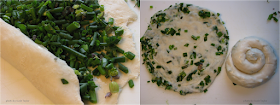One batch of rhubarb cordial turns into three summer drinks. Perfect for warm evenings on the front porch.
 |
| From the Left: The Rhubarb Sangria, The Rhubarb Royale, and The Rhubarb Daiquiri. One batch of rhubarb cordial provides the extra-special not-so-secret ingredient for all these drinks. |
 The Rhubarb Daiquiri
The Rhubarb Daiquiri(for a pitcher)
1/2 c. freshly squeezed lime juice
1-1/2 c. rhubarb cordial (see recipe below)
1 c. amber rum
(for an abstemious single drink)
1 oz. freshly squeezed lime juice
3 oz. rhubarb cordial
2 oz. amber rum
This is not the over-sweetened slushy stuff you get at Thank God I Don't Work Here on two-for-one Tuesdays. We have provided the measures for a single daiquiri, but make a pitcher. Really, make a pitcher. This is a rock star of a drink.
Mix all the ingredients in a glass pitcher sometime in the afternoon, like just before you weed your garden or take your dogs for a long walk. Chill in the refrigerator. Rim serving glasses using a wedge of lime and dredging in sugar (we like a martini glass for this). Put the glasses in the freezer. Go do something outside for a couple of hours. Give the daiquiri a stir before pouring into chilled glasses and enjoy. Here's the good news: because you made a pitcher, there's another one waiting for you.
 The Rhubarb Royale
The Rhubarb Royale(per single serving)
1 oz. rhubarb cordial (see recipe below)
3 oz. dry white cava
Pour one ounce of rhubarb cordial in the bottom of a champagne flute, top up with cava (about 3 oz.). Garnish with a curl of fresh rhubarb (a carrot peeler works perfectly for this). You could, of course, substitute champagne or other sparkling white wine for the cava, but why would you? Cava is a beautiful bubbly, made in the same method as champagne and is substantially less expensive than similar-quality french champagnes.
When we were moving from Ontario to Newfoundland, we took our time driving out. In Nova Scotia, we spent a few days at Risser's Beach Provincial Park, taking a break from the road, picking up sand dollars in the surf, and making ridiculously pretentious meals on our campfire (like fire-roasted beetroot and goat cheese salad). One day when we were too hot and tired for cooking, we drove down the road to MacLeod's Canteen and had fish & chips (some of the best fish & chips we ever ate, incidentally) and rhubarb fizz. We went back the next day for more rhubarb fizz. We are fans of fish & chips (who isn't?) but the rhubarb fizz completely stole the show, and we talk about periodically even now, 11 years later. The Rhubarb Royale is a grown-up (that is, alcoholic) tribute to that rhubarb fizz on the beach.
 |
| Hey... where did this cat come from? |
1 c. rhubarb mash (by-product of rhubarb cordial, see below)
1/2 c. brandy
1/2 c. freshly squeezed orange juice
1 bottle cheap red Spanish wine
orange wedges for garnish
ice cubes
In a blender, puree rhubarb mash and brandy. Pour rhubarb-brandy mixture into a glass pitcher or carafe (the container needs to be able to handle 1.5 liters of liquid). Let the flavours mingle for a little while (long enough to fold a load of laundry or do some dinner prep work). Add orange juice and red wine to the pitcher, stir thoroughly. Serve over ice in red wine glasses or tumblers, garnished with a wedge of orange.
Use an inexpensive red wine for this, but not one that will leave you with a headache. So pick a red wine you might drink on it's own, but stick to the lower price range that you typically buy from (we used a temperanillo). The rhubarb matches the wine for flavour and there's a lovely subtle burn from the brandy; altogether a beautiful way to boost your fiber intake and get a good dose of antioxidants; not to mention all that vitamin C between the rhubarb and the orange juice. Oh yes, we're totally selling this to you as a health-food...
How to Make a Ridiculously Easy Rhubarb Cordial
recipe adapted from Eat Like a Girl
2 lbs. rhubarb, chopped roughly (thumb-sized hunks)
1-1/2 c. water
1 c. (scant) sugar
Combine rhubarb, water and sugar in a heavy bottomed saucepan. Bring to a boil over medium heat and cook for about 15 minutes, until rhubarb is softened and has broken down and become stringy. The sauce should be slightly reduced and thickened. Stay in the kitchen while the rhubarb is cooking and watch your pot -- it can boil over suddenly if you aren't paying close attention (ask me how I know). Remove from heat and let cool about a half hour (hey, that's enough time to read a couple chapters of that book you are trying to finish!).
 |
| Left: Rhubarb chopped into thumb-sized pieces. Right: The thick stringy stew ready for straining. |
Most cordial instructions tell you to use a jelly bag for straining. We bought a jelly bag a few years ago and used it exactly once: for some reason, jelly bags are cat hair magnets, so it didn't last long in our house. We use a drip coffee system for straining cordials, jellies and such the like, and have found it has a couple of advantages. Firstly, the gold mesh filter does not seem to capture cat hair. Secondly, there is not need for creating a complex string and weights hanging system; you just set the filter on top of your jar and don't worry about it. Plastic drip holders and filters come in a couple of sizes (mug sized and coffee pot sized), are pretty inexpensive and a lot less messy than mucking around with muslin or jelly bags.




















